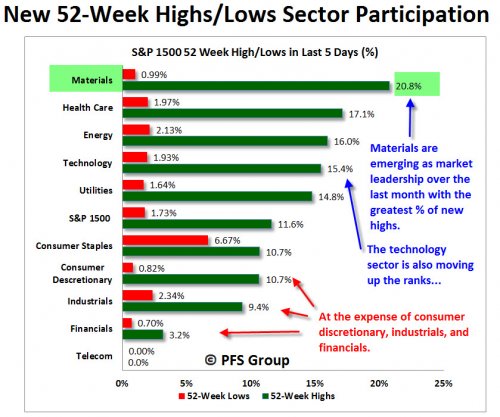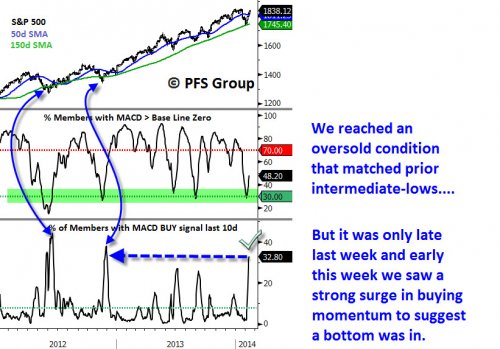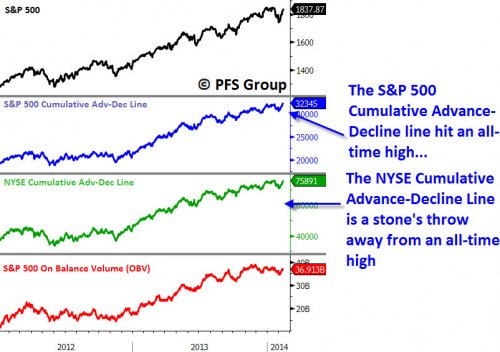As was highlighted in last Friday’s article, we had massive outflows from stock ETFs and concurrent massive inflows into bond ETFs which marked investor capitulation. I commented last week that we had an oversold condition that matched prior bottoms over the last few years but still needed one more ingredient for confirmation. That last ingredient was a surge in buying pressure to suggest the decline was over and that any rally attempt was not a dead-cat bounce. We finally had that missing element last Friday as the percentage of stocks with MACD buy signals surged well north of 10% over the prior ten trading days. In fact, the surge we’ve had is the biggest since the November 2012 lows, which at the time had set the stage for the strong 2013 rally. Throughout the decline I maintained we were merely dealing with a cooling off period in a strong bull market, and the data highlighted below continues to support the notion as the market’s long-term trend and momentum remain in bullish territory. One thing of note is that the correction and rally has revealed a change in character in market leadership, which appears to be moving from financials and consumer discretionary stocks to technology and basic materials.
Follow the Money – Weekly ETF Flows
When looking at inflows and outflows into major exchange traded funds (ETFs), we can see this past week was clearly risk-on with a total of $7.26B of inflows to large cap (SPY, IVV) and small cap (IWM) ETFs . Also of note is that $386M moved into the gold ETF (GLD). Looking at cumulative flows since early 2013 for GLD does show some stabilization and may mark a bottom (see chart below). On the other side of the ledger, we saw strong outflows from the energy sector (XLE) and REITs (IYR), as interest rates moved up, and mid-cap (MDY) stocks.

Source: Bloomberg
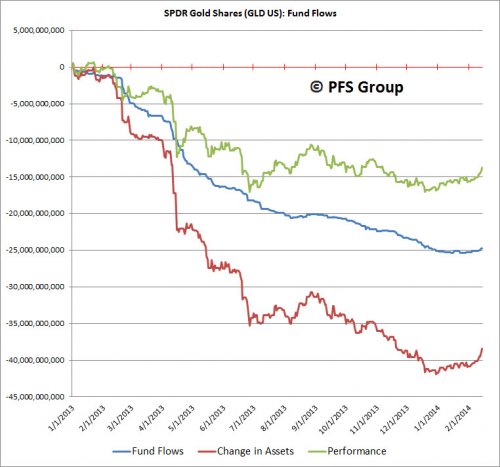
Source: Bloomberg
S&P 1500 Member Trend Strength
As shown below, the long-term outlook for the S&P 1500 is clearly bullish as 73.0% of the 1500 stocks in the index have bullish long-term trends. The market's intermediate-term outlook moved back into neutral-bearish territory by moving to 49.2% this past week from last week’s 37.2% reading. The market’s short-term trend remains in bearish territory at a 36.6% reading, though up from last week’s 25.2%.

* Note: Numbers reflect the percentage of members with rising moving averages: 200-day moving average (or 200d MA) is used for long-term outlook, 50d MA is used for intermediate outlook, and 20d MA is used for short-term outlook.
The most important section of the table below is the 200d SMA column, which sheds light on the market’s long-term health. As seen in the far right columns, you have 73.0% of stocks in the S&P 1500 with rising 200d SMAs and 73.0% of stocks above their 200d SMA. Also, eight out of ten sectors are in long-term bullish territory with more than 60% of their members having rising 200d SMAs, with the utility and telecom sectors the only ones with a reading below 60% at 32.8% and 46.7% respectively. Downside leadership in traditionally defensive sectors is not a cause for alarm. Of note, within the top four are cyclical sectors like industrials (86%), technology (84.2%), and materials (83.2%), which also supports a lack of evidence of a market top.
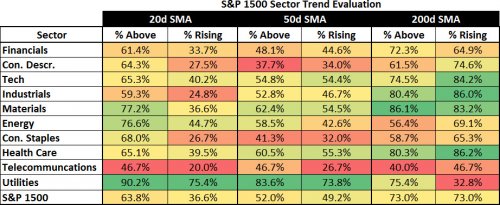
Source: Bloomberg
S&P 500 Market Momentum
The Moving Average Convergence/Divergence (MACD) technical indicator is used to gauge the S&P 1500’s momentum on a daily, weekly, and monthly basis. The daily MACD flipped back to a buy this week for the S&P 1500 while weekly MACD remains on a sell signal. Most importantly, the monthly buy signal given in 2012 remains in force as the market’s long-term momentum remains solid.

Source: Bloomberg
Digging into the details for the 1500 stocks within the S&P 1500 we can see that the daily momentum for the market has improved markedly from a reading of 17% last week to 69% this week. As stated in last week’s article, “readings below 20% are associated with short-term bottoms and why there is a strong chance we rally into next week,” and so this week’s rally was not surprising.
The intermediate momentum of the market also improved by inching up to 34% from last week. Currently, the weekly numbers are at levels we’ve seen with intermediate-term bottoms in the past.
The market’s long-term momentum remains solid at a strong 74% this week, putting it well into bullish territory as the market’s long-term momentum remains steady. The best way to read the table below is that we are still intermediate-term oversold in a bullish market with an improved short-term picture from last week.
Source: Bloomberg
52-Week Highs and Lows Data
What continues to be encouraging about the market is that even in the midst of a decline we still saw more new highs than new lows last week and this past week new highs clearly outnumber new lows regardless of market cap as the bulls continue to hold control of the market.
Source: Bloomberg
Over the last month we have seen some change in market leadership as industrials, financials, and consumer discretionary sectors move towards the bottom of the list to make way for materials and the technology sector. Healthcare was the leader last year and continues to be so this year as it never wavered its status during the decline.
Source: Bloomberg
Market Indicator Summary
Below is a multi-indicator chart of breadth and momentum in the S&P 500, which shows we reached an oversold condition early last week and that a snapback rally was highly likely. I wanted to see a surge in MACD buy signals north of 10% (very bottom panel) to declare the current rally anything more than a dead cat bounce. We got that in spades as nearly 33% of the 500 stocks in the S&P have received a daily MACD buy signal over the last 10 days. This marks the biggest surge in momentum since the November 2012 lows which set the stage for a strong multi-month rally.
Source: Bloomberg
Given the strong surge in momentum it isn’t surprising to see the S&P 500 Cumulative Advance-Decline Line hit an all-time high this week, with the NYSE Cumulative Advance-Decline Line only a stone’s throw away from hitting an all-time high as well.
Source: Bloomberg
Summary
The most important take away from this report is that the long-term trend and momentum of the market remain deep in bullish territory and so a rally after reaching an oversold condition comes as no surprise. What is bullish about the most recent selloff and rebound is that it produced the strongest surge in momentum in more than a year and suggests new highs in the market, which shouldn’t come as a surprise as the S&P 500 Cumulative Advance-Decline Line hit an all-time high this week. One thing of note is that we appear to have some sector rotation from industrials, consumer discretionary, and financials into basic materials and technology.


